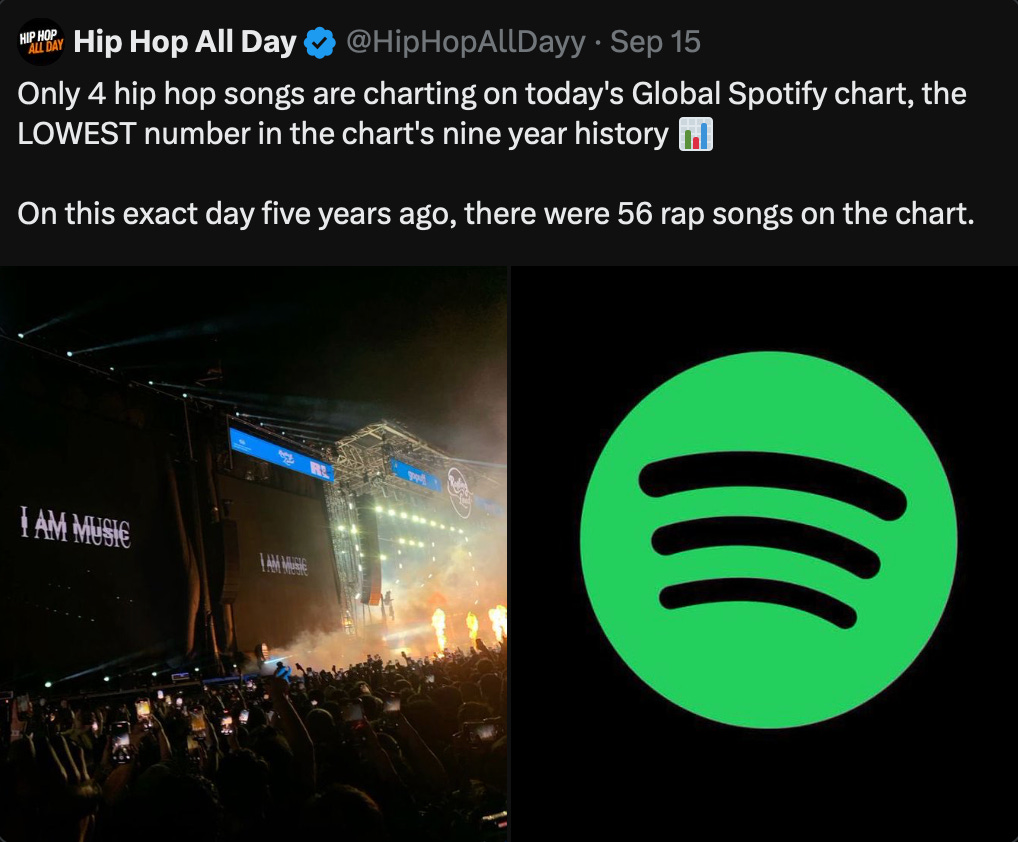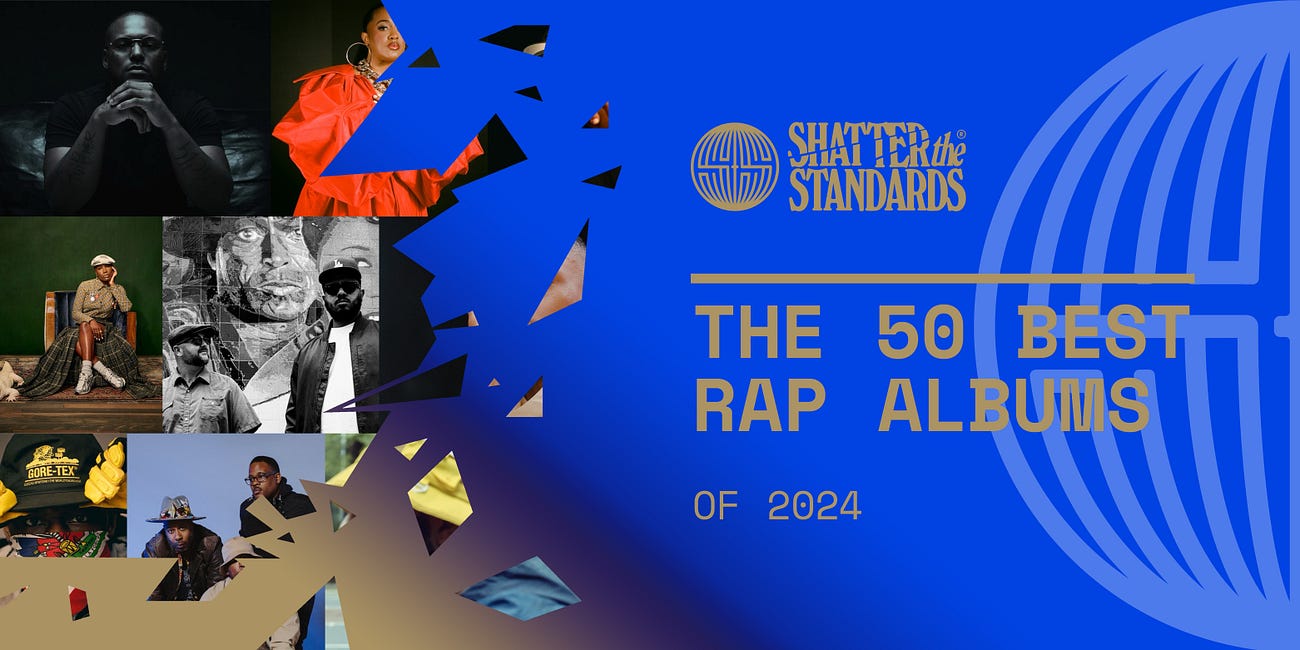It’s Not Kendrick Lamar’s Fault That the Labels Deprioritized Hip‑Hop
Major labels’ pivot in 2023 set the stage for a misinterpreted “hip-hop decline.” Lamar is not to blame for any lull; rather, industry strategy-driven narratives created a false idea of a dying genre.
In August 2023, Apple Music’s global editorial head Ebro Darden tweeted about a conversation with a label executive. The executive claimed that major labels were “de‑prioritizing signing rappers” and were instead pumping resources into African and Latin music. Ebro noted that this call wasn’t a trend piece—it was a practical warning. For years, rap had been the default genre for breaking artists; now labels were shifting budgets toward Afrobeats and Latin pop, two scenes that were drawing large, global streaming audiences. Commentators elaborated on the conversation, noting that executives saw rap as “monotonous and uninspiring” while Afrobeats and Latin music felt fresh. Others credited the meteoric rise of African artists like Asake, Rema, and Tems, whose sold‑out tours and Billboard-charting hits convinced labels that Afrobeats had crossover potential.
This pivot wasn’t the result of artistic exhaustion; it was an economic recalculation. Labels follow money, and by mid‑2023, the growth curves of Afrobeats and reggaeton were steeper than rap’s. Charts told part of the story: the USA Spotify Top 50 recorded an all‑time low hip‑hop market share in early 2023, while Latin and pop saw gains. However, the decline was relative—hip‑hop was still the second‑most prevalent genre among top artists globally. Yet the business conclusion was clear. As budgets tightened, the perceived redundancy of rap made it the easiest line item to cut.
Major label priorities rumble through the release calendar. When a label head decides that this quarter’s marketing budget will be allocated to an Afrobeats single instead of a rap album, there are ripple effects: fewer radio pushes, delayed rollout meetings, and smaller promotional budgets. By the end of 2023, many marquee rap releases were being held or quietly downsized. The effect was a drought on mainstream playlists. Yet this drought was often misinterpreted as cultural decline. A September 15th post noted that only four hip‑hop songs were present on Spotify’s Global Top 200, the lowest representation since the chart’s inception nine years earlier. Five years prior, there were fifty‑six. The viral tweet behind that report drew mournful conclusions, declaring that rap was “dead.” However, as Chartmetric’s analysts cautioned, a genre’s presence on top charts isn’t an exact measure of its health; hip-hop’s decline on the charts reflects market oversaturation, release timing, and competition from pop and Latin—not a decline in vanishing artistry.
Why do listeners equate chart position with cultural relevance? Because charts are easy to quantify, especially in the streaming era: Top‑50 lists, trending playlists, and global streaming numbers create a scoreboard for genres. But those lists represent a tiny fraction of all music released and are heavily skewed by superstar drops. When the Drizzler releases an album, the overall share of hip‑hop spikes because his tracks occupy half the list. When he and other stars go quiet, the share drops. This volatility says more about release strategies than about creativity on the ground. Chartmetric’s Is Hip‑Hop Really Declining? report notes that hip‑hop artists produced more music in 2023 than any other genre and that emerging rappers are increasingly exploring other categories—electronic, pop, R&B, and Latin—further blurring lines.
The global decline narrative also erases regional strength. Outside the United States, the fall in hip‑hop’s market share was much less severe—Spotify’s Top 50 Global saw only a 24% drop. YouTube’s global charts indicate that hip-hop held an 11–14% share in early 2024. These numbers reveal a genre that remains influential but is no longer monopolizing attention. Yet a section of rap fandom—often anchored in the orbit of one or two megastars—interpreted the drop as proof that Kendrick Lamar’s success had “killed” rap.
In early 2024, hip‑hop experienced a polarizing moment. Kendrick Lamar’s lyrical assault on an unnamed Canadian superstar ignited one of the most riveting rap battles in years. The feud dominated discourse and drew millions of streams, but it also exposed fault lines between industry machinery and cultural vitality. Instead of celebrating the artistry, certain male fans—particularly those aligned with the rival’s brand—weaponized the chart numbers. They argued that Kendrick’s dominance proved he had “ended” rap, even though their favorite kept releasing singles throughout 2024 and 2025. This claim was a projection, not a fact. Chart slumps were the result of labels deprioritizing hip‑hop, not Kendrick’s success.
Industry whispers of a Great Rap Reset circulated in mid‑2024. After the feud, some mainstream rappers postponed albums, fearing unfavourable comparisons or an inhospitable market. Vibe published an interview where veteran MC Fat Joe lamented that 2024 might be the “worst year in hip‑hop history,” pointing to controversies and negativity around the beef. On social media, fans chastised artists like JID for promising year‑long drops but delivering only a handful of freestyles.
The message boards nicknamed it a “reset” year—a season of silence as stars regrouped. Yet even this lull is exaggerated. Andscape noted that 2024 produced strong projects across generations despite the feud. The disparity between mainstream fatigue and underground productivity underscored a core truth: hip‑hop’s health is independent of any one star. Don’t believe us, check out our list from last year.
The 50 Best Rap Albums of 2024
They proclaim it every year, and for us, 2024 truly stood out for rap music, especially when one looks beyond mainstream trends. This year offered diverse rap styles, showcasing established artists and newcomers. We have selected our 50 best rap albums from this year—some of which made the main STS list while many did not.
By the summer of 2025, the so‑called Rap Reset looked like a pause before a flood. Veteran spitters, underground heroes, and rising newcomers released a wave of albums that restored the culture’s momentum. Across this summer, you could feel rap flexing from every direction. A reunited Clipse cut through with a sharp, veteran record in Let God Sort Em Out, the kind of no-frills contest album that treats writing like sparring. Ghostface kept the old-master energy alive with Supreme Clientele 2 landing late August, a ruthless, 22-cut statement that still swings like iron. JID stepped squarely into the main event with God Does Like Ugly, a clean, big-canvas LP that plays like a victory lap and a reset at once. Westside Gunn stayed in motion with Heels Have Eyes 2, folding his art-fashion fight-club aesthetic back into bar work, and Chance pointed the telescope back at mainstream attention with Star Line, hitting mid-August.
Zoom out, and the bench is just as loud. Earl Sweatshirt’s Live Laugh Love arrived with the wry intensity only he can get away with. Leikeli47 tore off the mask and rolled out Lei Keli ft. 47 / For Promotional Use Only; Raekwon returned with The Emperor’s New Clothes, a chef’s-table plate of mafioso detail, and Wildchild’s Child of a Kingsman reminded people that Oxnard drum-slinging can still feel brand-new. Ché Noir kept her hot streak intact with The Color Chocolate 2; D Smoke planted a flag with Wake Up Supa, Evidence’s Unlearning Vol. 2 gave grown-man rap a crisp new spine, Open Mike Eagle’s Neighborhood Gods Unlimited delivered concept TV as autobiography, and Gabe ’Nandez leveled up with Preservation on Sortilège.
Even the wider orbit joined the pile-on: Arrested Development dropped Adult Contemporary Hip Hop for Independence Day, Public Enemy surprise-released Black Sky Over the Projects: Apartment 2025, and $ilkMoney’s wonderfully unhinged long-titled LP put teeth on the year’s underground provocations. Add Sækyi’s concise debut Lost in America, Nick Grant’s I Took It Personal, Loyle Carner’s Hopefully !, Radamiz & Fortes’ Lightman, and Little Simz’s Lotus, and the throughline isn’t scarcity—it’s output: different eras, different regions, all rapping.
This cascade of releases demolished the narrative that hip‑hop was “dead.” If anything, the post‑reset year offered an embarrassment of riches, with rap albums from across the diaspora, across generations, and across stylistic spectrums. It also underscored how labels' 2023 pivot created a false vacuum; once the major‑label floodgates reopened, the culture overflowed.
So why does the villain narrative persist? Partly because fans invested in one superstar’s myth need a scapegoat when their idol loses a battle. In the feud’s aftermath, OVO‑aligned stans insisted that Kendrick Lamar’s dominance had “ended” rap. They pointed to Spotify’s global chart slump and the absence of mainstream rap on the radio as proof. Yet they ignored that their favourite continued to release music in 2024 and 2025 and that many of their complaints were directed at his oversaturation, not at Kendrick’s existence. The psychological projection is obvious: rather than admit that a cultural shift stems from industry decisions, they project death onto the competitor.
This narrative erases hip‑hop’s decentralized vibrancy. Outside the mainstream calendar, rap thrives in underground scenes, independent labels, and cross‑genre collaborations. The Great Rap Reset may have slowed major‑label output, but independent artists filled the void. Sækyi’s intimate storytelling, Ché Noir’s introspective bars, Gabe ‘Nandez’s philosophical musings, and Radamiz’s life‑affirming album all arrived without the promotional muscle of corporate giants. Their existence proves that hip‑hop’s heart never stopped beating; only the corporate pipeline experienced arrhythmia.
Labels’ pivot to Afrobeats and Latin music also invites a necessary conversation about genre classification and Black music. Chartmetric notes that as genres globalize, Western categories blur; artists like Bad Bunny or Rema might produce music that fuses rap, reggaeton, R&B, and Afrobeat, yet industry metadata often reduces them to one tag. When labels reallocate resources from hip‑hop to “African” or “Latin” music, they’re usually still funding rap derivatives. The decline of “hip‑hop” share can coincide with the rise of Latin trap or Afro‑rap. Thus, the narrative that labels abandoned hip‑hop ignores the fact that they’re simply chasing new subsets of the same tradition.
The myth that Kendrick Lamar “killed” rap by winning a feud collapses under scrutiny. The drought preceded the feud; labels deprioritized hip‑hop in 2023 due to a strategic pivot towards Afrobeats and Latin music. Chart declines reflect release timing and market saturation, not artistic death. The Great Rap Reset was a momentary pause triggered by fear and insecurity, not a casket. By 2025, the culture rebounded with a deluge of albums across regions and generations, from Clipse and Ghostface Killah to Radamiz and $ilkMoney. The vibrant release schedule proves that hip‑hop is alive, adaptive, and thriving.
If there is a villain, it’s the industry itself: the executives who chase trends and reallocate budgets without regard for artistic ecosystems. And perhaps it’s also the fans who twist chart numbers into death knells and weaponize feuds to bolster stan agendas. Kendrick Lamar remains one of rap’s most important voices, but he isn’t omnipotent; he cannot kill a culture built on resilience and reinvention. Hip‑hop’s pulse beats not on a global chart but in the mouths of rappers across the world who continue to spit truth, defy categories, and push the culture forward. The labels may deprioritize, the charts may fluctuate, but the music persists.




